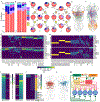Organization of an ascending circuit that conveys flight motor state in Drosophila
- PMID: 38402616
- PMCID: PMC10939832
- DOI: 10.1016/j.cub.2024.01.071
Organization of an ascending circuit that conveys flight motor state in Drosophila
Abstract
Natural behaviors are a coordinated symphony of motor acts that drive reafferent (self-induced) sensory activation. Individual sensors cannot disambiguate exafferent (externally induced) from reafferent sources. Nevertheless, animals readily differentiate between these sources of sensory signals to carry out adaptive behaviors through corollary discharge circuits (CDCs), which provide predictive motor signals from motor pathways to sensory processing and other motor pathways. Yet, how CDCs comprehensively integrate into the nervous system remains unexplored. Here, we use connectomics, neuroanatomical, physiological, and behavioral approaches to resolve the network architecture of two pairs of ascending histaminergic neurons (AHNs) in Drosophila, which function as a predictive CDC in other insects. Both AHN pairs receive input primarily from a partially overlapping population of descending neurons, especially from DNg02, which controls wing motor output. Using Ca2+ imaging and behavioral recordings, we show that AHN activation is correlated to flight behavior and precedes wing motion. Optogenetic activation of DNg02 is sufficient to activate AHNs, indicating that AHNs are activated by descending commands in advance of behavior and not as a consequence of sensory input. Downstream, each AHN pair targets predominantly non-overlapping networks, including those that process visual, auditory, and mechanosensory information, as well as networks controlling wing, haltere, and leg sensorimotor control. These results support the conclusion that the AHNs provide a predictive motor signal about wing motor state to mostly non-overlapping sensory and motor networks. Future work will determine how AHN signaling is driven by other descending neurons and interpreted by AHN downstream targets to maintain adaptive sensorimotor performance.
Keywords: ascending neuron; connectomics; corollary discharge circuit; efference copy; ventral nerve cord.
Copyright © 2024 Elsevier Inc. All rights reserved.
Conflict of interest statement
Declaration of interests The authors declare no competing interests.
Figures






Update of
-
Organization of an Ascending Circuit that Conveys Flight Motor State.bioRxiv [Preprint]. 2023 Jun 9:2023.06.07.544074. doi: 10.1101/2023.06.07.544074. bioRxiv. 2023. Update in: Curr Biol. 2024 Mar 11;34(5):1059-1075.e5. doi: 10.1016/j.cub.2024.01.071. PMID: 37333334 Free PMC article. Updated. Preprint.
Similar articles
-
Organization of an Ascending Circuit that Conveys Flight Motor State.bioRxiv [Preprint]. 2023 Jun 9:2023.06.07.544074. doi: 10.1101/2023.06.07.544074. bioRxiv. 2023. Update in: Curr Biol. 2024 Mar 11;34(5):1059-1075.e5. doi: 10.1016/j.cub.2024.01.071. PMID: 37333334 Free PMC article. Updated. Preprint.
-
An Array of Descending Visual Interneurons Encoding Self-Motion in Drosophila.J Neurosci. 2016 Nov 16;36(46):11768-11780. doi: 10.1523/JNEUROSCI.2277-16.2016. J Neurosci. 2016. PMID: 27852783 Free PMC article.
-
A population of descending neurons that regulates the flight motor of Drosophila.Curr Biol. 2022 Mar 14;32(5):1189-1196.e6. doi: 10.1016/j.cub.2022.01.008. Epub 2022 Jan 31. Curr Biol. 2022. PMID: 35090590 Free PMC article.
-
The self as part of the sensory ecology: how behavior affects sensation from the inside out.Curr Opin Insect Sci. 2023 Aug;58:101053. doi: 10.1016/j.cois.2023.101053. Epub 2023 Jun 6. Curr Opin Insect Sci. 2023. PMID: 37290318 Review.
-
A New Perspective on Predictive Motor Signaling.Curr Biol. 2018 Mar 5;28(5):R232-R243. doi: 10.1016/j.cub.2018.01.033. Curr Biol. 2018. PMID: 29510116 Review.
Cited by
-
A Closer Look at Histamine in Drosophila.Int J Mol Sci. 2024 Apr 18;25(8):4449. doi: 10.3390/ijms25084449. Int J Mol Sci. 2024. PMID: 38674034 Free PMC article. Review.
-
Insect Flight: State of the Field and Future Directions.Integr Comp Biol. 2024 Jul 9;64(2):533-55. doi: 10.1093/icb/icae106. Online ahead of print. Integr Comp Biol. 2024. PMID: 38982327 Free PMC article.
-
Distributed control circuits across a brain-and-cord connectome.bioRxiv [Preprint]. 2025 Aug 2:2025.07.31.667571. doi: 10.1101/2025.07.31.667571. bioRxiv. 2025. PMID: 40766407 Free PMC article. Preprint.
-
Regulation of diel locomotor activity and retinal responses of Anopheles stephensi by ingested histamine and serotonin is temperature- and infection-dependent.PLoS Pathog. 2025 Apr 28;21(4):e1013139. doi: 10.1371/journal.ppat.1013139. eCollection 2025 Apr. PLoS Pathog. 2025. PMID: 40294029 Free PMC article.
-
Comparative connectomics of the descending and ascending neurons of the Drosophila nervous system: stereotypy and sexual dimorphism.bioRxiv [Preprint]. 2024 Jun 28:2024.06.04.596633. doi: 10.1101/2024.06.04.596633. bioRxiv. 2024. PMID: 38895426 Free PMC article. Preprint.
References
-
- von Holst E, and Mittelstaedt H (1950). Das Reafferenzprinzip. Naturwissenschaften 37, 464–476. 10.1007/BF00622503. - DOI
MeSH terms
Grants and funding
LinkOut - more resources
Full Text Sources
Molecular Biology Databases
Miscellaneous

